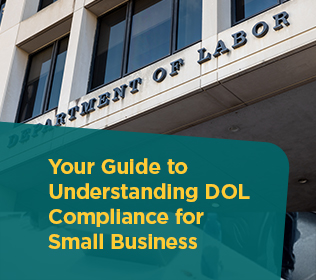
Flexible jobs, remote, and hybrid work schedules have become the new normal in the business world. However, there may be some workplace compliance implications employers should be aware of while working to keep employees happy, focused, and engaged.
Opportunities for employees to perform their job duties without physically being in the office is no longer a novelty perk; it’s an expectation from job seekers and employees alike. In the initial months of the coronavirus outbreak, employers praised workers for their ability to adapt quickly and accomplish their work in unprecedented circumstances. Now, most employers plan to call on their employees once again to adapt to another major shift: returning to the office.
Companies that have already enacted full-time return-to-office (RTO) mandates face serious pushback from their employees. Because of this, business owners and decision-makers have to carefully consider a multitude of factors as they determine whether to enact RTO requirements, hybrid work schedules, and flexible hours.
You may be among the many industry leaders debating this very issue. In your discussions, be sure investigate what solutions are most suitable for your office, how to manage employees’ schedules, and be prepared for any additional workplace compliance regulations that may apply to flexible jobs and hybrid work schedules.

Return to the Office or Implement Hybrid Work Schedules?
To figure out the most fitting schedule solutions for your business, you should evaluate what worked best for your employees before the pandemic, when the general standard was for everyone to be in the office full-time, and what your employees value most about working remotely.
Before making the decision to call your employees back to the office full-time, it’s a good idea to begin with a few thought exercises: examine the business case for a return-to-office (RTO)mandate or hybrid work schedules, and consider the potential employee experience for each.
The Business Case to Return to the Office
Decision-makers across industries have cited a need to recapture in-person collaboration and redevelop a thriving company culture as the reason to bring employees back to the office for their full-time, five-day workweek.
In fact, recent Gallup data shows strong evidence that office friendships are even more valuable since the start of the pandemic. Employees who have best friends at work contribute to positive business outcomes encompassing profitability, safety, inventory control, and retention. These connections can improve employee well-being and can forge connections with managers and higher-level executives, paving the way for career development and higher job satisfaction.
According to Gallup’s article, employees who have a best friend at work are significantly more likely to:
- Engage customers and internal partners
- Get more done in less time
- Support a safe workplace with fewer accidents and reliability concerns
- Innovate and share ideas
- Have fun while at work
Some business leaders have also leaned into perceived benefits of having employees return to the office. For employers, seeing employees in the office can offer a sense of heightened security and control over sensitive information. Similarly, it is common for decision-makers to believe close supervision improves productivity. Though the true impact of these examples are debated, they are often included in the decision-making process.
Finally, SHRM collected insights from c-suite executives as to why they are calling employees back to the office. One of the main reasons cited by CEOs is a belief that for employees to best advance their careers, they need to be in the office to collaborate in person with more experienced workers to gain the skills they need for career advancement.
The Employee Experience of Fully Returning to the Office
Employees are accustomed to working from home and have ultimately expressed a lack of interest in returning to the office full-time.
A publication from MIT Sloan Management Review offered some thought-provoking research and commentary on this topic. Trends are showing that RTO mandates crush employee engagement and increase turnover—especially for women, caregivers, and other underrepresented groups in the office. Interestingly, the employees with the highest likelihood of attrition due to RTO mandates are high-performing employees.
As people adjusted to remote work, they also adjusted their mindset. They re-evaluated the role work played in their lives. This caused a profound shift among the workforce and became a contributor to a high level of resistance to return to the office full-time. A publication from The Conference Board reported that
43% of workers under the age of 35 would quit if called back to the office full-time.
Evidence is mounting that RTOs result in negative business outcomes. Each small and medium-sized business is different and there’s no one-size-fits-all answer to the question, “should I bring my employees back to the office for good?” Fortunately, there is a solution that allows employee and employer to meet each other halfway.
The Business Case for Hybrid Work Schedules
With so much attention on the debate between returning to the office or allowing workers to stay remote, hybrid work schedules have become a popular compromise.
In a recent survey, executives reported seeing the best team performance from either a three to four-day in-office mandate or “at-will” hybrid work, meaning employees can decide which days to come in. Further research showed that employees do their best skilled work at home, where distractions are minimal and they can concentrate better. Additionally, keeping workers home was found to create office space cost-savings of roughly $10,600 per employee, per year.
So far, the greatest advantages of hybrid work schedules include
- Flexible job hours for employees
- Improved personal well-being and productivity at work
- Lowered burnout
Hybrid work schedules are used by 63% of high-growth organizations and 62% of the overall workforce agree that the ability to work remotely influences their decisions to stay with their company or not.
The Employee Experience of Implementing Hybrid Work Schedules
Employers find substantial benefits in creating a hybrid work policy for their staff. This is largely due to the value employees find in the office and at home.
Multiple workforce surveys show agreement that hybrid workers feel they are better able to prioritize their health and well-being. They have reported being able to maintain a satisfactory work-life balance, reduced stress around things like doctor appointment and caretaking, and an appreciation for additional “me” time.
A recent analysis concluded that employees who work remotely at least once per month are 24% more likely to feel happy and productive in their roles than those who don’t. Additionally, 76% of employees have saved money through hybrid work, saving on commute-related expenses.
If hybrid schedules are the way to go for your business, here are a few tips to help you get started.

Tips for Managing Employees’ Hybrid Work Schedules, Remote Work, and Flexible Jobs
Choose Structured Work Schedules
Some successful scheduling models include:
- Having employees come into the office on set days of the week
- Alternating schedules – one week in the office, one week remote
- Split schedules – if possible, create hybrid schedules that ensure each department has at least one team member in the office per day
Keep Lines of Communication Open
A common complaint from executives and other leadership is that communication suffers when the full team is not in the office full-time. Here are some solutions for that:
- Set regular, recurring meetings with your full team
- Schedule periodic 1:1s with each of your team members to ensure you’re both up-to-date and aligned on projects
- Share new projects and important deadlines verbally, in meetings, and in writing by follow-up email
- Share documents with the full project plan, details, and schedule
- Share and request project status updates
- Use software that allows real-time document collaboration (an additional benefit to real-time documents help employees avoid saving over each other’s work
Foster Team Collaboration and Engagement
Positive relationships in the workplace are a great motivator for employees. When given a hypothetical choice, 65% of American workers said they would prefer being friends with their colleagues than to have a 10% salary increase.
With this in mind, have departmental leaders evaluate the work their employees do. Then, be strategic about choosing which duties should be completed independently and what projects can benefit from a collaborative effort.
Another way to keep workers engaged is to be diligent in making time to recognize and reward your staff, even in virtual meetings. Allowing employees some latitude to have non-work-related conversations in separate messaging channels also helps foster positive regard. Leaders can also consider calling the team in on the same day to engage in team-building activities.
Incorporate Positive Work Culture Regardless of Where Your Employees Are
An employer’s secret weapon for top-tier recruitment is an authentically positive work culture, so it’s imperative to get it right. This type of in-office environment boosts productivity, improves employee engagement, and decreases turnover. For these reasons, it is imperative for businesses to get this right.
The actions and attitudes of your leadership and managerial teams are powerful drivers in determining your company’s work culture. Even the way leaders give and receive feedback, guide performance and approach employee recognition are foundational to the culture being built.
Here are five ways to ensure your company has a positive work culture
- Allow your teams some flexibility for time and space to produce. Creativity and collaboration cannot be rushed.
- Give all employees the opportunity to have a seat at the table and share their ideas.
- Encourage transparency and open communication from employees to leadership.
- Create additional opportunities for employees to get to know each other at and outside of work.
- Above all else, remember empathy is an essential quality of a healthy workplace.

Aspects of Remote and Hybrid Work Schedules to Consider for Workplace Compliance
Allowing employees to work a hybrid, flexible, or fully remote schedule includes more than enacting a policy. If you decide to start or continue offering remote flexibility, there are legal issues that may impact your workplace compliance and tax compliance procedures.
There are also some workplace compliance implications small and medium-sized businesses owners should pay attention to. Let’s take a look at some of the most common needs to consider for remote and hybrid work schedules.
Protecting Company, Client, and Employee Data
Regardless of who works where, you must ensure that your company’s data, as well as your clients’ data, is protected at all times.
Here are some of the most common ways data is compromised:
- Using public Wi-Fi or unsecured networks, which are highly vulnerable to cyber attacks
- Leaving laptops or computers open or unattended—even in the office
- A too-simple login process and weak passwords
- Employees not knowing what to do if they think data may have been compromised
Here are some of the best ways to avoid these security pitfalls
- Encourage your employees to only work off of a private Wi-Fi network
- Take measures such as employee training, backing up data, and running security checks regularly
- Create a policy of using multi-factor authentication for logins to verify user identity
With these varied levels of security, you’ll be able to better protect your data no matter where your employees sign in.
Payroll Administration and Tax Compliance
Once you’ve covered data security, you’ll need to turn your focus to record-keeping. If your company is not set up to properly report and remit taxes, your company could face audits, fines, penalties, and other legal ramifications for not properly remitting taxes.
According to the National Conference of State Legislators, the physical location of where an employee with a hybrid work schedule actually does their work may impact tax requirements for your business. This may include filing tax returns in multiple states.
Conveniently, technology like VPNs or IP login systems can not only help protect employee data and other sensitive information, but it can also streamline location tracking for you and your hybrid workers.
Wage and Hour Issues
You will also need to pay attention to the wage and hour issues specific to the state and locality your employee works in. States, and even some cities, can vary greatly in minimum wage rates, overtime computation, sick pay, exempt salary thresholds, and other wage and hour laws.
When it comes to remote and hybrid workers, you’ll need an accurate system to calculate and pay your employees for their time. This system should be available for both in-person workers as well as those working remotely.
Finally, don’t offer “comp time” to your employees. Comp time refers to allowing employees to take equivalent hours off as PTO instead of paying an overtime rate for any hours worked over 40. This practice is generally illegal.
Workplace Compliance
Ensure you seek out and follow all other compliance laws that are applicable to your employees’ physical locations. Workers’ compensation laws, equal employment opportunity (EEO) laws, and more can also vary by state. If your employee moves, you’ll need to be alerted so that you can make sure you have incorporated their new state’s laws into your employment practices.
Enacting a helpful and thorough hybrid work policy can be complicated, especially for a new business owner. PrestigePEO’s HR consulting services help SMBs ensure workplace compliance and even help businesses create work policies and custom, legally compliant employee handbooks.
Connect with a PEO to Help Your Employees Return to the Office
Flexible jobs, remote work—and hybrid work schedules especially—are more popular now than ever before. Offering flexibility in your employment opportunities will keep your business competitive in the eyes of job seekers, but there are plenty of additional administrative obligations to meet. To pull it off without pulling out your hair, you’ll need a team of specialists on your side.
A relationship with PrestigePEO will connect you with a dedicated team of our in-house experts who will be extension of your current HR staff. We’ll guide you through your business’ changing needs, from payroll administration to workplace compliance to employee benefits administration and beyond. When you need additional HR support, we’ll do what we do best: take care of the details so you can get back to growing your business.




